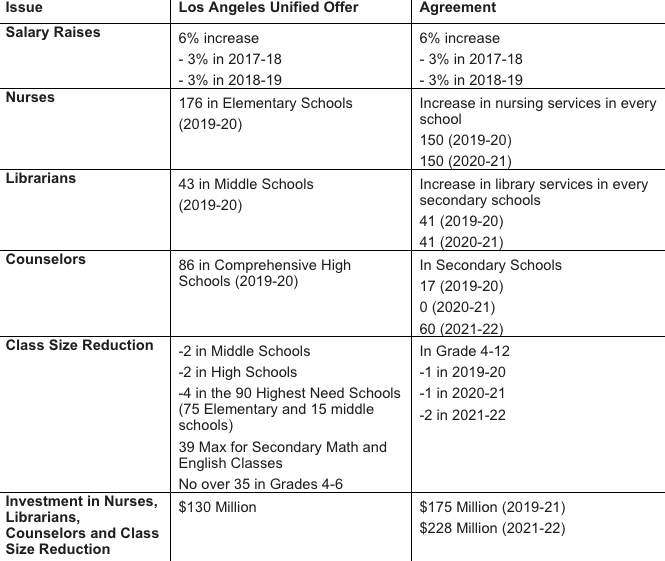Teachers overwhelmingly approved a new contract Tuesday and planned to return to the classroom after a six-day strike over funding and staffing in the nation’s second-largest school district.
Although all votes hadn’t been counted, preliminary figures showed that a “vast supermajority” of some 30,000 educators voted in favor of the tentative deal, “therefore ending the strike and heading back to schools tomorrow,” said Alex Caputo-Pearl, president of United Teachers Los Angeles.
Los Angeles Mayor Eric Garcetti, accompanied by leaders of the union and the Los Angeles Unified School District, announced the agreement at City Hall a few hours after a 21-hour bargaining session ended before dawn.
“This is a good agreement. It is a historic agreement,” Garcetti said.
The deal was broadly described by officials at the news conference as including a 6 percent pay hike and a commitment to reduce class sizes over four years.
Specifics provided later by the district and the union included the addition of more than 600 nursing positions over the next three school years. Additional counselors and librarians were also part of the increase in support staff.
Marianne O’Brien said the need for additional support staff was one of the main reasons she walked picket lines.
“This is not just for teachers. It’s also for counselors, nurses, psychologists and social workers,” said O’Brien, who teaches 10th grade English.
The new contract also eliminates a longstanding clause that gave the district authority over class sizes, officials said. Grades 4 through 12 would be reduced by one student during each of the next two school years and two pupils in 2021-22.
Clashes over pay, class sizes and support-staff levels in the district with 640,000 students led to its first strike in 30 years and prompted the staffing of classrooms with substitute teachers and administrators.
The district maintained that the union’s demands could bankrupt the school system, which is projecting a half-billion-dollar deficit this budget year and has billions obligated for pension payments and health coverage for retired teachers.
District Superintendent Austin Beutner said he was delighted the deal was reached. But he hinted that financial challenges remained.
“The issue has always been: How do we pay for it?” Beutner said. “That issue does not go away now that we have a contract. We can’t solve 40 years of underinvestment in public education in just one week or just one contract.”
Under the tentative agreement, the district, the union and the mayor’s office will work jointly to “advocate for increased county and state funding” for Los Angeles schools, according to the UTLA summary.
The Board of Education was expected to move quickly to ratify the deal, which would expire at the end of June 2022.
The deal came as teachers in Denver voted to go on strike as soon as next Monday. More than 5,000 educators would be affected. The main sticking point is increasing base pay and lessening teachers’ reliance on one-time bonuses for having students with high test scores or working in a high-poverty school.
In Oakland, California, some teachers called in sick last week as part of an unofficial rally over their contract negotiations, which also hinge partly on a demand for smaller class sizes.
Thousands of boisterous educators, many wearing red, and their supporters gathered on the steps outside City Hall where the tentative agreement was announced.
The crowd began cheering, blowing horns and chanting the initials of Caputo-Pearl as the smiling union leader emerged from the building and walked through the throng.
Joaquin Flores, a special education teacher, said he believed he would support the deal unless it weakened health care or didn’t go far enough to reduce class size.
“It’s almost like metaphoric,” Flores said. “The sun’s out. When we started, it was all rainy and cold. I feel like it’s a new day.”
Before teachers voted on the contract, Sharon Maloney said she was reluctant to support it without seeing details. She was skeptical that the district had made enough concessions on class size, health care benefits for new teachers or that the superintendent would spend enough of about $2 billion in reserves.
“I suspect the motives of Beutner,” Maloney said.
Teachers hoped to build on the “Red4Ed” movement that began last year in West Virginia and moved to Oklahoma, Kentucky, Arizona, Colorado and Washington state. It spread from conservative states with “right to work” laws that limit the ability to strike to the more liberal West Coast with strong unions.

We entered contract negotiations with four objectives and this agreement will achieve all of them: Provide educators with a well-deserved 6% raise, reduce class sizes and provide more support to students and educators including nurses, counselors and librarians…
— L.A. Unified (@LASchools) January 22, 2019





















